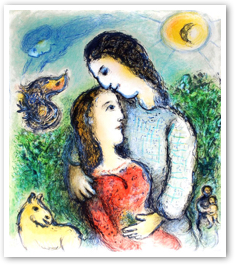Courtship in the Age of the Pill
Turning around the institution of marriage will have to involve the restoration of courtship, albeit not as it was sixty years ago.
There is much discussion these days about the crisis of marriage. Divorce rates are high, too many children live in single-parent homes, people often end up isolated and lonely in middle age. But there is little discussion about courtship. How does one enter marriage? How should a 25 year-old negotiate what is still quaintly called the dating scene?
According to philosopher Leon R. Kass, the reason there is so little discussion about courtship is that "the very terms — 'wooing,' 'courting,' 'suitors' — are archaic; and if the words barely exist, it is because the phenomena have all but disappeared. Today, there are no socially prescribed forms of conduct that help guide young men and women in the direction of matrimony. . .for the great majority, the way to the altar is uncharted territory: It's every couple on their own, without a compass, often without a goal."
This virtual absence of guidelines for courtship is unprecedented. Until recently, society had clear norms governing the "dance" between a man and woman prior to marriage. There are reasons why this is no longer the case, aside from a few exceptions.
First, we live in what Barbara Dafoe Whitehead calls a Divorce Culture. Many young adults have parents who are divorced and so lack both counsel and a compelling model for matrimony. The painful endings of their parents' marriages make them wary of commitment.
Second, there has been a dramatic shift in priorities regarding work and family. People now want financial independence before they think about marriage, whereas their parents (and certainly grandparents) often married before their financial situation was clear. Fifty years ago, young couples expected to scrape by during the early years of marriage, and this often strengthened the relationship.
"If you wait until your 30's," writes Charles Murray, "your marriage is likely to be a merger. If you get married in your 20's, it is likely to be a start-up. . . .What are the advantages of a start-up marriage? For one thing, you will both have memories of your life together when it was all still up in the air. . . .Even more important, you and your spouse will have made your way together. . . .And each of you will know that you wouldn't have become the person you are without the other."
Third, many bachelors are inclined to live out what Kay Hymowitz calls a "postmodern post-adolescence." This state of emotional suspension has been portrayed in sitcoms like "Seinfeld." Young men (and not a few female peers) see no compelling reason to move on to full adulthood; they may not even be sure what the word means.
For men, the delay of adult responsibility is partly explained by the availability of sex with no strings attached. "If the culture offers sexual access and does not require in exchange personal commitment," writes James Q. Wilson, "a lot of men will take the sex every time."
Sex, once reserved for marriage, is now almost an automatic part of dating. This has not clarified thinking or enriched emotions. Casual sex has created a climate of cynicism among young people, who get into the habit of treating members of the opposite sex as a means to an end. To make sex a casual activity is to shrink the meaning of courtship — and therefore of marriage itself.
Modernity puts great emphasis on freedom, but has little to say about how to use that freedom. A case in point is the sexual revolution, which has had a devastating impact on courtship and marriage. As a general matter, it is difficult, at this late date, to claim that the sexual revolution has made people happier. It might be easier to make the opposite case. Consider, for example, the out-of-wedlock birthrate, now over 40 percent in America and the U. K., or the epidemic of STD's.
The sexual revolution was launched by the introduction of the contraceptive pill for women. The Pill was meant to "liberate" women. But it had a number of unforeseen consequences — unforeseen, at any rate, by those who were most vigorous in promoting it.
Modernity puts great emphasis on freedom, but has little to say about how to use that freedom.
The Pill gave men a permission slip to have sex with no responsibility; they could demand it with no concern for the consequences. It became easier for men to treat women as vehicles for pleasure. (Some women responded in kind.) This commodification of physical pleasure evacuated the sexual act of its nuptial meaning. It made men and women look at each other in ways that have little to do with the covenant of permanent self-giving that is marriage.
The Pill also helped create a "hook-up culture" which — as even feminist writers with a liberationist bent like Donna Freitas admit — has caused much pain and frustration, especially among women. It's not hard to see that sexual promiscuity both on campus and afterward has resulted in a lot of men and women entering marriage with a jaded, consumerist attitude toward sex.
The Pill also helped to create a culture of cohabitation prior to marriage. In 1960, the year the Pill was introduced, virtually no couples lived together before marriage. Now 60 percent do. And it turns out that cohabitation is not a helpful entry into marriage. For one thing, it teaches couples low-intensity commitment: separate names and bank accounts, an agreement that "we can split anytime." Many couples discover too late that cohabitation and marriage are not the same thing at all.
Turning around the institution of marriage will have to involve the restoration of courtship, albeit not as it was sixty years ago. A 23 year-old graduate student recently told me that the scenario now is to shack up with a guy who may or may not turn out to be your husband and not think about marriage until about age thirty. Her generation needs to hear why this often is a formula for being miserable by the time they turn fifty.
http://www.catholiceducation.org/en...-topics/courtship-in-the-age-of-the-pill.html







 I clicked that off button so fast.
I clicked that off button so fast.